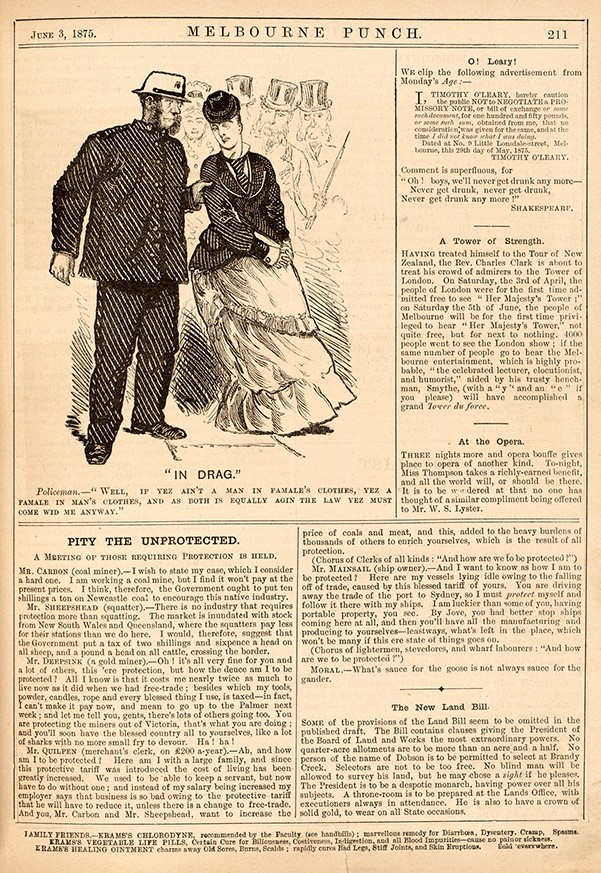While living at St Kilda's Etloe Hall (Oberwyl) with her parents, young Kate Johnson attracted the attention of Melbourne Punch magazine for her cross-dressing escapade. And became an instant media sensation. Was she St Kilda's first celebrity?
By Ken Norling. Images courtesy National Library of Australia
St Kilda’s first celebrity?
“Who would be obscure, when notoriety may be had so cheaply!”
In June 1875, Kate Johnson, a young St Kilda resident, became an instant sensation in Melbourne, when she paraded on the fashionable Collins Street block dressed in a combination of male and female clothing.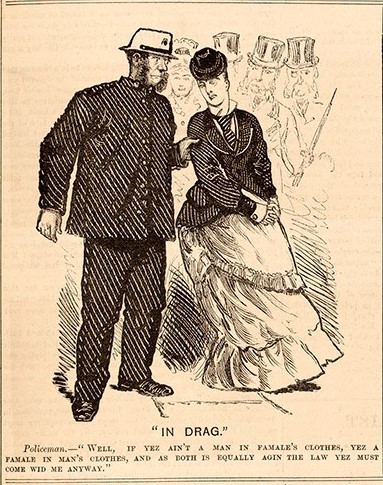
The humorous magazine, Melbourne Punch, recorded the event with a cartoon on June 31, which suggests Kate had to immediately deal with the long arm of the law:
"IN DRAG."
Policeman.—“WELL, IF YEZ AIN’T A MAN IN FAMALE’S CLOTHES, YEZ A FAMALE IN MAN'S CLOTHES, AND AS BOTH IS EQUALLY AGIN THE LAW YEZ MUST COME WID ME ANYWAY.” http://nla.gov.au/nla.news-page20447907
The ‘boy-girl’, as Punch promptly designated her, provided a staple for the magazine’s humour for following months, with a series of increasingly disparaging cartoons and occasional quips2.
FURTHER DEVELOPMENT OF THE "BOY GIRL." CAN BE SEEN ANY FINE DAY ON THE BLOCK BETWEEN THE HOURS OF 4 AND 5. https://trove.nla.gov.au/newspaper/article/174549673
By November, Punch’s “Hardened Contributor” was ready to expound his views on the vice of ‘Boy-Girlhood.’3 Unsurprisingly, it’s an essay in condescension and dismissal, beginning with the notice that “your Hardened Contributor will proceed to impart instruction to those ladies who feel themselves aggrieved with the sex that Nature and-their well-meaning parents have bestowed on them.”
He then proceeds to an interview with the “king-queen of the boy-girls,” though it seems likely that the ‘interview’ owes far more to the imagination of the Hardened Contributor, than to any conversation with his subject. His account does point to a symbiotic relationship between sensationalist newspapers and their subjects which would not be out of place in the age of the Kardashians, when the “distinguished neuter” explains,
Now look ye here, old hoss, I don't mind giving you the straight tip and laying you on to all I know. You scratch me and I'll scratch you. Punch has made me notorious, and damme I'm not ungrateful —I'm not, you bet your last dollar on that !
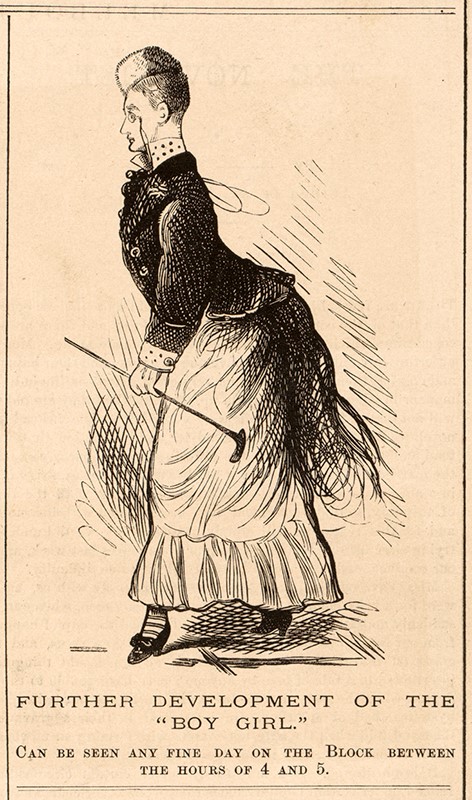 The Hardened Contributor then describes what is required to join the boy-girls:
The Hardened Contributor then describes what is required to join the boy-girls:
… the young aspirant must have her hair cut close, style of crop a la Coburg. She will then borrow her brother's soft felt hat—she will surround her pure and spotless bosom and its adjacent ribs with a jacket that is a cross between a double-breasted frock coat and a page's button-bristling jacket—she purchases a short cane, and she prigs her father's eyeglass—she will proceed to do the block—she talks slangily, laughs loudly, stares impudently at the passers-by through her gold-rimmed window-pane, and she is famous! Who would be obscure, when notoriety may be had so cheaply!
The response to the Hardened Contributor’s final question, as to the purpose of becoming a ‘boy-girl’ seems more revealing of his fears, rather than any proto-feminist manifesto of the real ‘boy-girl:’
To the equality of the sexes and the establishment of women's rights. Why should the men monopolise all the swearing, and swiping and other good things of this world? Eve gave Adam his bite of the apple in the old times, and, damme! I don't see why the girls oughtn't to be allowed a taste of the forbidden fruit now. My motto is, 'fair halves--share and share alike in the sinful amusements that go so far to make this life endurable!’
There’s no evidence that Kate Johnson spawned a movement, despite the fears of the Hardened Contributor. It may have been because other potential ‘boy-girls’ did not have the protection of a wealthy parent, as cross-dressing was very much against the law. A court report from 1859, for example, records that “Ann Lawlor was sent to prison for three months for disguising herself in male attire.”4 The only report of imitation provoked by Kate Johnson’s appearance came in January 1876, when Margaret Dooley was charged with wearing a gentleman's clothes in the unsavoury surrounds of a lane off Little Lonsdale Street. It was reported that she “did the feat of the boy girl for a wager of two drinks.” She was let off with a caution.5
An explanation for the boy-girl phenomenon was finally offered in a newspaper report, which claimed that Johnson’s “eccentric conduct was said to have been the result of a wager of £1,000 with a wealthy squatter that she would not appear daily in this dress ‘on the block’ for a certain period.”6 That may have been true, and Margaret Dooley’s case may well have been an imitation of the bet, though the size of Johnson’s bet seems fanciful, as the amount suggested was equivalent to more than 25 years’ wages for a domestic servant.
In June 1875, Kate Johnson had only recently turned seventeen. She was the daughter of a squatter, Archibald Johnson, who had begun life in Australia in 1839 as a station overseer, and had risen to be the owner of a number of properties in western Victoria. When he died in 1881, he left an estate that was worth more than $40 million in today’s money. 7
Archibald Johnson appears to have suffered a stroke – or a series of strokes – that left him partially paralysed in the early 1870s, and in 1873 he and his family moved to Melbourne. They lived for a year in Studley House in Kew, and then moved to St Kilda in 1874, taking up residence at Etloe Hall in Burnett Street, the house we now know as Oberwyl. They were to remain there until late 1877, when Johnson bought Toorak House, a former residence of governors of Victoria, and its 44 acres of land. (The house survives as Stonnington in Glenferrie Road.)
The boy-girl disappeared from the streets of Melbourne by the end of 1875. Nothing more was heard of Kate Johnson for some time, though it is likely that she spent much of 1876 training as a musician and actor, probably under the tutelage of the veteran St Kilda musician and impresario, Coleman Jacobs. In October, she began to appear in fund-raising concerts, one for a cricket club, another for the family of a deceased military officer.8 The notoriety she had acquired was, however, not forgotten, and was to play a major part in shaping a career which took off spectacularly during 1877.
(The attraction of the arts for the Johnson family seemed to extend beyond Kate, as her sister Mary married the celebrated organist and conductor David Lee in 1877. https://adb.anu.edu.au/biography/lee-david-4006)
Kate’s first public appearances in 1877 came in March, when she appeared in “vocal and instrumental” concerts in the Assembly Hall, Grey Street, St Kilda, organised by Coleman Jacobs.9 (The Assembly Hall still stands, though substantially modified in 1881, when it became the St Kilda Coffee Palace.) The critics were positive, with the Australasian particularly praising her:
Mr. Coleman Jacobs's concert at the St. Kilda Assembly-hall, on the 22nd inst., was artistically most successful and agreeable. …. Miss Kate Johnston's piano-playing surprised the audience by its brilliancy, and Mr. Coleman Jacobs himself showed that he had lost none of his former cunning.10
The review in the Herald also picked out Kate Johnson, noting that she “gave great satisfaction by her rendition of the various numbers allotted to her, especially the Lullaby, composed and dedicated to this young lady by Alberto Zelman.”11 Zelman was at that time well into his forties, a prominent figure in Melbourne music, and we will never know whether the composition was inspired by his recognition of Kate’s musical skills, or simply an eye for an attractive young woman.
Zelman was not the only composer to cast Kate Johnson as his muse. In October 1877 the Argus acknowledged receipt of “a sonata for pianoforte, in B flat, composed by Alfred Meyer, and dedicated to Miss Kate Johnson. This is the first time that Mr. Meyer's turn for composition has adopted the form of the sonata, and, like his other first attempts, it is a very crude one; but as he has before now improved in other directions, so in this he may improve if he studies a great deal more before he publishes his next piece.”12
The following month, Jacobs and his pupils moved to a bigger stage, appearing in a “grand amateur concert" at the Melbourne Atheneum. It was a busy time for Kate, who had turned nineteen the week before. Again, the Australasian was envious of her abilities:
On Thursday night, at the Athenaeum, a very pleasant concert was given by Mr. Coleman Jacobs, who, I need hardly say, is well and favourably known to the Melbourne musical world. He was assisted by several lady and gentleman amateurs, among whom was Miss Kate Johnson, a young lady of whom I have before had occasion to speak, both as an accomplished pianiste and as a very charming actress. Miss Johnson has quite an astonishing facility in the execution of brilliant passages on the pianoforte, and … her power of control deserves to be particularly mentioned. I must say l take it as an evidence of great natural kindness when a young lady places her rare talents at the service of a professional musician in this way.13
It was the beginning of a busy year. On May 1 1876, Kate appeared on stage again at the Assembly Hall, when the “St. Kilda Amateur Dramatic Club gave their fourth performance. … The dominant attraction on this, as on the last occasion, was the appearance of Miss Kate Johnson, and I have at once to say that her acting … may well be taken as a justification of the curiosity manifested to see her.”14 On June 8, she appeared as principal guest in a benefit concert for Coleman Jacobs at the Academy of Music in Ballarat, performing both on pianoforte, and as Katherine in a three-act adaptation of Shakespeare’s Taming of the Shrew.15 Later that month she was reprising her role as Katherine on the boards of the Academy of Music in Bourke Street, now as part of Joseph Simmons’ Melbourne Dramatic Academy.16
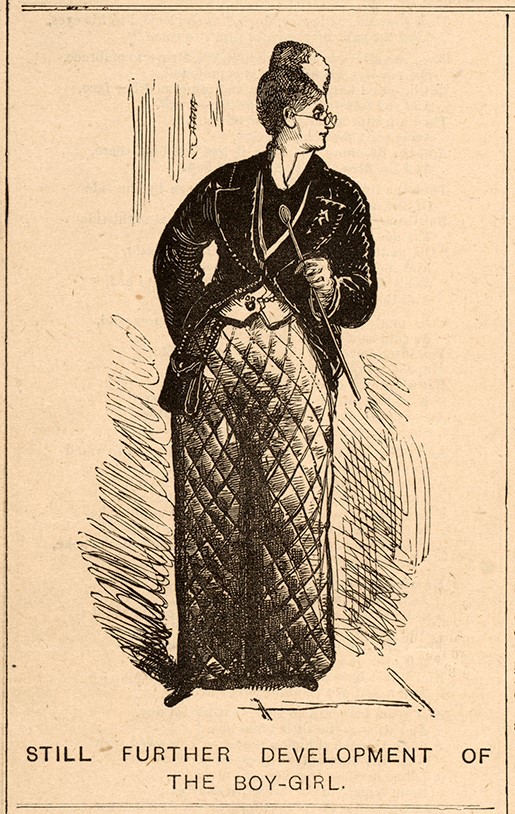 It's clear that Kate’s previous incarnation as the boy-girl contributed to her success, The Ballarat Star noted that “the debut here of Miss Kate Johnson, a Melbourne amateur of much fame, … helped very potently to draw the great host of patrons to the Academy. A more brilliant array in dress circle and boxes has never been seen here, and we are pleased to infer that Mr Jacobs has achieved a substantial success. …”17
It's clear that Kate’s previous incarnation as the boy-girl contributed to her success, The Ballarat Star noted that “the debut here of Miss Kate Johnson, a Melbourne amateur of much fame, … helped very potently to draw the great host of patrons to the Academy. A more brilliant array in dress circle and boxes has never been seen here, and we are pleased to infer that Mr Jacobs has achieved a substantial success. …”17
Similarly, the Illustrated Australian News report of the Athenaeum concert commented that “the part of Katherine was taken by Miss Kate Johnson, the daughter of a wealthy colonist, and this caused the house to be filled to overflowing each night.”18
The Argus, meanwhile, was reassuring its readers that Kate was no half-male, stressing her feminine qualities:
Miss Johnson has certainly a great advantage in respect of appearance. She has a well-proportioned, agreeably ample figure, and a face naturally pleasant and expressive. Her voice, if not strong, is far from unpleasing, and there is evidence of intelligence sufficient to justify the belief in our capability to comprehend well what she undertakes.19
The extent to which Kate’s fame had spread through the colony by then can be seen in a report in the Alexandra and Yea Standard, Gobur, Thornton and Acheron Express:
Miss Kate Johnson, who some time ago provided a continual subject of amusement to the frequenters of the Block and places of public amusement, by the peculiar style she assumed, which secured her the sobriquet of ‘The Boy-Girl,’ has adopted another role, in which she will have a still better chance of rendering herself notorious. She recently appeared on the stage of the Academy of Music, as Katherine, in the ‘Taming of the Shrew,’ and is announced for a starring tour in the provinces.20
However, the projected provincial tour did not extend beyond two nights in the Mechanics’ Institute in Geelong in early August, again with Simmons’ Melbourne Dramatic Academy, again with Kate in a leading role as Shakespeare’s Katherine.21
By now the reviews of Kate’s acting were fairly uniform. Some were willing make allowances for her youth and inexperience, but there was little encouragement for her dramatic career in the Melbourne papers, while Kate’s previous notoriety meant that her performances drew attention even in the provincial press. The Portland Guardian’s correspondent advised by telegram that “Performance by Kate Johnstone (boy-girl) last night was a complete failure as showing her histrionic ability.”22 The Ballarat Star’s correspondent was no more favourable: “last night the Academy of Music was thronged to witness the performance of the boy girl of the block. Fashion in sealskin jackets and elegant continuations fairly overflowed into the building to witness the debut of the boy-girl. The result was a disappointment so complete that after to-night we shall have little chance of witnessing her performances again.”23
The Weekly Times was more scathing, with a review which questioned the motives of those who had placed Kate on the stage:
Had it been a Siddons, a Rachel, a Mrs. Jordan, or a Ristori, there could not have been a larger crowd present than assembled within the walls of the Bijou Theatre (Academy) on Wednesday night, to witness Miss Kate Johnson's impersonation of Kate, in ‘Taming of the Shrew,’ with a number of other amateurs, who were announced as the pupils of Mr. Simmons, sen. It was a fashionable audience, too, for feminine vice-royalty was present; but the one sentiment which seemed to actuate everybody was curiosity. Neither regard nor sorrow were expressed for an amiable, accomplished, well-meaning, but badly-counselled young girl, who madly rushed in ‘where angels fear to tread.’ There was an almost frenzied desire manifested on all sides to be present to watch the outcome of what was popularly supposed to be a new freak of a young lady who already established a more than local reputation for eccentricity. The result was a fiasco, pure and unadulterated — whereat the multitude rejoiced. For myself, I would it had been otherwise. I should have joyed exceedingly to have seen that young girl triumph over the sneers and polite jibes of her friends and acquaintances by a marvellous exhibition of genius; but it was not to be. She has no qualifications whatever for the line she has so hurriedly and rashly taken up, and it is to be sincerely hoped she will no longer suffer herself to be made a show of, in much the same way as the armless woman, the spotted boy, or the double-headed calf, in order to afford Mr. J. Simmons, or anybody else, the opportunity of filling his pockets. I would write a critical account of Miss Johnson's attempt to play the part, but that it is not really worth the trouble.24
While the critical reviews of her dramatic persona piled up, acknowledgments of her musical abilities continued to appear. Her “brilliancy,” her “remarkable skill, care, and precision,” and her “astonishing facility in the execution of brilliant passages on the pianoforte” were regularly noted. When Kate appeared purely as a musician in an appearance with Lyster’s Opera Company, even the critic from the Weekly Times was impressed:
A concert followed the opera, and this was the most enjoyable part of the entertainment. … there was an addition in the shape of Miss Kate Johnson, who appeared this time in her own proper role — that of an accomplished pianoforte player. She performed Ascher's ‘Danse Negro,’ and executed the very difficult music with taste, skill, and brilliancy. Her efforts met with, the warm recognition of the large audience, and she was unanimously recalled, and made to play an encore.25
Whatever the views of the critics, by the end of 1877, Kate Johnson had become a regular performer on the stages of Victoria, and her presence on a bill was a reliable way of filling halls.
However, fame and fortune did not await her. On February 25 1878, The Argus recorded the death “on the 24th inst, at Toorak house, Toorak, Kate, second daughter of Archibald Johnson, Esq , of Tahara, aged 19 years.” She was victim of a common scourge of the nineteenth century, typhoid fever.26
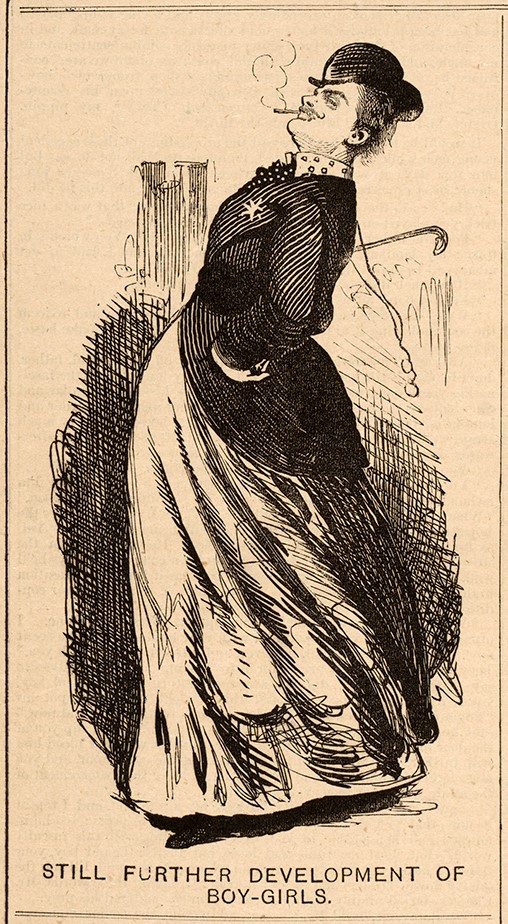 The extent of Kate’s notoriety as the boy-girl was revealed by the range of newspapers which carried reports of her death. It included provincial papers in Beechworth, Kyneton, Castlemaine, Geelong, Ballarat, Bendigo and Hamilton, while coverage was not restricted to Victoria. Reports appeared in Sydney and Adelaide papers, and also further-flung interstate publications at Launceston, Kiama, Yorke's Peninsula, Gawler, Mount Gambier, Wagga Wagga, and Armidale (New England).
The extent of Kate’s notoriety as the boy-girl was revealed by the range of newspapers which carried reports of her death. It included provincial papers in Beechworth, Kyneton, Castlemaine, Geelong, Ballarat, Bendigo and Hamilton, while coverage was not restricted to Victoria. Reports appeared in Sydney and Adelaide papers, and also further-flung interstate publications at Launceston, Kiama, Yorke's Peninsula, Gawler, Mount Gambier, Wagga Wagga, and Armidale (New England).
The most substantial reports appeared in the Mount Alexander Mail:
It was a shock to society this morning to learn that a young lady, whose foibles over the excusable outcome of the high spirits of youth, had been suddenly taken from us. Her eccentricities of dress had made her at one time conspicuous, but since the marriage of her elder sister these had been modified and a brilliant social career was anticipated for her. Although her dramatic powers were of a lesser order than some of her flattering friends imagined they had in them a rich promise of. future development, and her musical abilities were by many good judges held in high estimation. I allude to Miss Kate Johnson, of Toorak House, a well-known amateur actress and accomplished musician, died on Sunday, aged nineteen.27
and The South Australian Advertiser:
The Miss Kate Johnson, of Toorak House, whose death was noticed in our Victorian telegrams on Monday, was the young lady who for some time in Melbourne was known as the ‘boy-girl,'’ from the fact that she paraded Collins-street in a costume more nearly approaching male than female attire. This eccentric conduct was said to have been the result of a wager of £1,000 with a wealthy squatter that she would not appear daily in this dress ‘on the block’ for a certain period, and judging by the time that she was seen there attired as a boy she had nerve enough to dare public opinion and win her wager. Her parents, who purchased the ex-viceregal residence at Toorak, are very wealthy, and her sister is married to a Melbourne musical celebrity. The death of this clever though eccentric young person will occasion regret amongst a large circle of fashionables in the Victorian metropolis, to whom her virtues as well as her singularities were well known.28
The Kyneton Guardian went further, with a detailed report of the funeral:
THE LATE MISS KATE JOHNSON, OF TOORAK. —The remains of this accomplished young lady, who has been called away from this world at the age of nineteen, were interred in the Melbourne General Cemetery on Tuesday last. Toorak House, well known as the former Government House, which was purchased a few months ago by A. Johnson, Esq, of, Tahara, though built in the early days of the colony, is still probably the best private residence in the suburbs of Melbourne, and most resembles, with its surrounding grounds, some of the manor houses in England. This beautiful home Miss Johnson was not permitted to enjoy, for the family had scarcely entered on possession when she was seized with low fever, evidently the result of previous severe study and failing health. This did not cause any apprehension till last week, when it assumed a severe typhoid type, which terminated fatally in four days. Shortly before three o'clock on Tuesday, a numerous company assembled in the large dining room, where Divine service was conducted by the Rev. Charles Strong, of the Scots Church, and the Rev. J. Don, of St. Andrew's, Kyneton, who was for many years minister of the congregation to which Mr. Johnson belonged in South Australia. The coffin, consisting of an inner one of lead, and an outer one of polished oak, was then placed in a hearse, drawn by four black horses, mounted with white plumes. Then followed a long train of mourning coaches and private carriages, which passed through Toorak, South Yarra, and crossed the Prince's Bridge, on the way to the cemetery. The city streets were lined by thousands of people, who gazed with silent awe as the cortege passed, and who seemed to sympathise deeply with the sorrowing friends; for young lady was known to all Melbourne, not only for her great musical abilities, but for her beauty and amiable disposition. Nothing could impress the minds of the multitude more deeply than this funeral procession with the vanity of all earthly wishes, and of the fearful impartiality of death, for wealth has no power to bribe, nor beauty to charm, the destroyer. It was then felt doubtless by all that there are times when those surrounded by splendor and affluence need consolation from the powers of the world to come, as much as the inmates of the humblest cottage. They felt for those bereaved parents, whose favorite and flower was taken, and whose fine home will thus long be left unto them desolate. A large crowd assembled at the cemetery, but excellent order was maintained. After a short prayer, offered by the Rev. Mr Strong, the coffin, on which was placed many wreaths of immortelles, was lowered into the vault.29
Other reports were far shorter, and appear to be based on telegraphic communications. The Wagga Wagga Advertiser’s report is typical: “Miss Kate Johnson, the amateur actress and singer of Melbourne, died on Sunday last at Toorak House, Toorak, aged 19 years.”30 Many included a reference to Kate’s past as the “boy-girl,” while at least one added rather snobbishly that she was a “daughter of a rich lower-order man.”31
This was an abrupt end to a life that seemed to promise much. We cannot even begin to guess how Kate Johnson’s life would have fared, had it not been cut so short. It’s hard to think it could have been anything less than spectacular, given the talents, inventive imagination and strength of character she had displayed in her brief public career. Victorian Melbourne was clearly robbed of a strong and bold woman, who could have substantially enriched its culture and society.
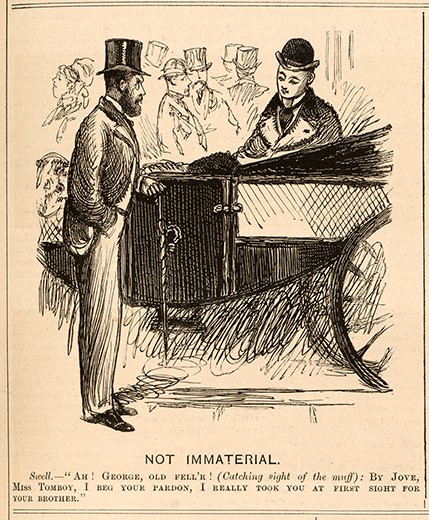
Image Captions (top to bottom)
Melbourne Punch, 3 June 1875, p.1. National Library of Australia nla.obj-10788009
Melbourne Punch, 3 June 1875, p.1. National Library of Australia nla.obj-10788009 (cropped)
Melbourne Punch, 1 July 1875, p. 1. National Library of Australia nla.obj-10788011
Melbourne Punch, 26 August 1875, p. 8. National Library of Australia nla.obj-10789598
Melbourne Punch, 30 September 1875, p. 7. National Library of Australia nla.obj-10789600
Melbourne Punch, 17 June 1875, p.1. National Library of Australia nla.obj-10789596
Notes
1. Melbourne Punch, 1875, June 3 , p. 1.
2. Melbourne Punch , 1875, June 17, p. 1, FURTHER DEVELOPMENT OF THE "BOY GIRL." Melbourne Punch , 1875, July 1, p. 1, STILL FURTHER DEVELOPMENT OF THE BOY-GIRL. Melbourne Punch , 1875, August 26, p. 8, STILL FURTHER DEVELOPMENT OF BOY-GIRLS. Melbourne Punch , 1875, September 30, p. 7.
3. PRACTICAL PAPERS ON VICE. Melbourne Punch , 1875, November 11, p. 6.
4. POLICE. The Age, 1859, February 5, p. 3.
5. POLICE. The Herald, 1876, January 18, p. 2.
6. The South Australian Advertiser, 1878, February 26, p. 5.
7. THE LATE MR. ARCHIBALD JOHNSON, OF TAHARA. Hamilton Spectator, 1881, October 15, p. 3.
8. NEWS OF THE DAY. The Age, 1876, October 4, p. 3, Advertising The Argus, 1876, November 15, p. 12.
9. Advertising. The Argus, 1877, March 10, p. 12.
10. COMMUNICATED. The Australasian, 1877, March 31, p. 19.
11. NEWS OF THE DAY. The Herald, 1877, March 23, p. 2.
12. The Argus, 1877, October 23, p. 5.
13. ENTERTAINMENTS. The Australasian, 1877, April 28, p. 19.
14. ENTERTAINMENTS. The Australasian, 1877, May 5, p. 19.
15. Advertising The Ballarat Star, 1877, June 8, p. 3.
16. NEWS OF THE DAY. The Herald, 1877, June 20, p. 3.
17. MR COLEMAN JACOB’S BENEFIT. The Ballarat Star, 1877, June 9, p. 2.
18. THE MONTH. Illustrated Australian News, 1877, July 9, p. 99.
19. ACADEMY OF MUSIC. The Argus, 1877, June 21, p. 7.
20. MELBOURNE LETTER. Alexandra and Yea Standard, Gobur, Thornton and Acheron Express, 1877, July 28, p. 2.
21. Advertising Geelong Advertiser, 1877, July 31, p. 3.
22. LATEST TELEGRAMS. Portland Guardian, 1877, June 22, p. 2 (EVENINGS.).
23. MELBOURNE. The Ballarat Star, 1877, June 22, p. 3.
24. THE STAGE. Weekly Times, 1877, June 23, p. 13.
25. THE STAGE. Weekly Times, 1877, June 30, p. 13.
26. Family Notices The Argus, 1878, February 25, p. 1.
27. MELBOURNE. Mount Alexander Mail, 1878, February 26, p. 3
28. The South Australian Advertiser, 1878, February 26, p. 5.
29. THE INFLUENCE OF THE PRESS Kyneton Guardian, 1878, March 2, p. 2
30. ITEMS OF NEWS. Wagga Wagga Advertiser¸1878, February 27, p. 2.
31. Colonial& Intercolonial Messages. Australian Town and Country Journal, 1878, March 2, p. 9.




